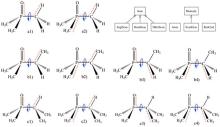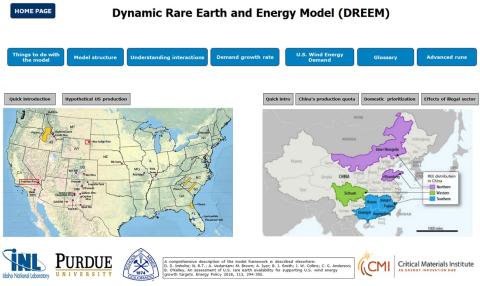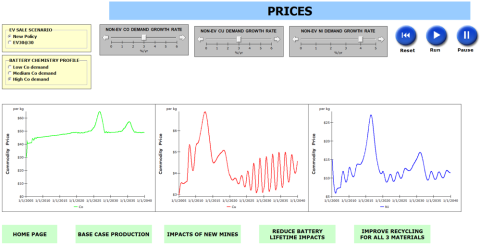Success for the Critical Materials Innovation Hub will be defined by how well it meets its mission to assure supply chains of materials critical to energy technologies. One goal of CMI is minimizing the time to discovery and the time between discovery and deployment. To do this, the CMI team includes both research and industrial partners. Another way is developing tools for research. Several tools developed by CMI scientists are open source software. Force-Field Parameter Fitter (ParFit) and HostDesigner can help researchers reduce research time from years to months. LOGKPREDICT software interfaces the machine learning predictive abilities of chemprop with the ligand design software HostDesigner. DREEM is A System Dynamics Model for Assessing Dynamic Rare Earth Production, Demand and U.S. Wind Energy Demand. The CoCuNi Model allows researchers to analyze how supply chains of cobalt, copper and nickel will be affected by electric vehicle (EV) deployment scenarios. The Lithium Supply Analysis Model (LISA) can be used to assess the viability of U.S. lithium supply from geothermal brine and potential supply chain impact of extracting lithium from this source. Each of these is described in further detail on this page, and links are provided for more information or to reach the open source software.
Parfit
Force-Field Parameter Fitter (ParFit) is a flexible and extendable framework  and a library of classes for fitting force-field parameters to data from high-level ab-initio calculations on the basis of deterministic and stochastic algorithms. The code is written in Python with object-oriented constructs and is using the highly versatile Python libraries numpy, scipy, matplotlib and pyevolve. The code fits MM3 and Merck force-field parameters, and could be extended to other force-field types.
and a library of classes for fitting force-field parameters to data from high-level ab-initio calculations on the basis of deterministic and stochastic algorithms. The code is written in Python with object-oriented constructs and is using the highly versatile Python libraries numpy, scipy, matplotlib and pyevolve. The code fits MM3 and Merck force-field parameters, and could be extended to other force-field types.
ParFit is an open source software package developed by CMI researchers Federico Zahariev, Nuwan De Silva, Mark S. Gordon, Theresa L. Windus, and Marilú Pérez García. They published the work in the Journal of Chemical Information and Modeling link. ParFit is available for download here.
HostDesigner
HostDesigner is a computer-aided molecular design code that enables the general application of de novo structure-based methods to problems in chemistry and material science. Its purpose is to identify organic molecules with 3D structures that match user-input specifications. To accomplish this, the code connects chemical fragments to build millions of potential molecules, evaluates the resulting structures based on geometric constraints, and outputs a rank-ordered list of candidates. Example applications include the design of metal ion sequestering agents for use in separations processes, molecules that form self-assembled nanoscale containers, and molecular building blocks for metal-organic frameworks.
HostDesigner was developed by Benjamin P. Hay of Supramolecular Design. HostDesigner has been updated over time; the current version is available here.
LOGKPREDICT
LOGKPREDICT software is available here: https://github.com/Critical-
LOGKPREDICT is open source software designed by Federico Zahariev, Marilú Pérez García, and Tamalika Ash.
DREEM
DREEM is A System Dynamics Model for Assessing Dynamic Rare Earth Production, Demand and U.S. Wind Energy Demand, developed by CMI researchers located at Idaho National Laboratory with input from CMI researchers at Purdue University and Colorado School of Mines. The software and license are available online at https://github.com/IdahoLabResearch/DREEM
A detailed description of the model can be found in this article published in Energy Policy:
https://www.sciencedirect.com/science/article/pii/S0301421517307383

CoCuNi (Kokanee) Model
CMI researchers at Idaho National Laboratory developed the CoCuNi (Kokanee) model and released it on GitHub, an open-source platform: https://github.com/IdahoLabResearch/CoCuNi The model allows critical materials researchers to analyze how supply chains of cobalt, copper and nickel will be affected by electric vehicle (EV) deployment scenarios. This model links global demand and supply of three intertwined materials cobalt (Co), copper (Cu) and nickel (Ni) in a simulation market model with explicit consideration of electric vehicle (EV) and battery scenarios. By incorporating feedback between supply, demand, prices and capacity expansion, we quantify realistic production scenarios for both primary (mining) and secondary sources (recycling). Furthermore, to understand the magnitude of material (battery) demand from the in-use EV stock, we also consider demand to replace end-of-life (EOL) batteries. We seek to answer the following questions: 1) How will production from both primary and secondary sources react to various EV deployment scenarios and battery-chemistry combinations? 2) How much supply might promising/potential new (mining) projects contribute to supply? 3) What is the impact of reducing battery lifetime? 4) If recycling rates are increased for all 3 materials, what are the implications for Co production?
A detailed description of the model is available in the article published in Resources, Conservation and Recycling: Global Electrification of Vehicles and Intertwined Material Supply Chains of Cobalt, Copper and Nickel.

Lithium Supply Analysis Model (LISA)
CMI researchers at Idaho National Laboratory Ange-Lionel Toba and Ruby Nguyen developed the Lithium Supply Analysis Model (LISA) to assess the viability of U.S. lithium supply from geothermal brine and the potential supply chain impact of extracting lithium from this source. This model links global lithium demand and supply considering different electric vehicle (EV) demand scenarios. This model was built using the system dynamics modeling method. Detailed description of the model can be found in the article published in Resources, Conservation and Recycling: U.S. lithium resources from geothermal and extraction feasibility. As the application is built using Venapps, special user interfaces that simplify user interaction with Vensim models, users must have a current Vensim license to open and run it. Steps to run the model and more information on how to access the software, check details at this Idaho National Laboratory webpage.
Model files: https://inlbox.box.com/s/c6tz0uzj9fh8rsvt09helcq379qucn79 Link to GitHub: https://github.com/IdahoLabResearch/LISA

